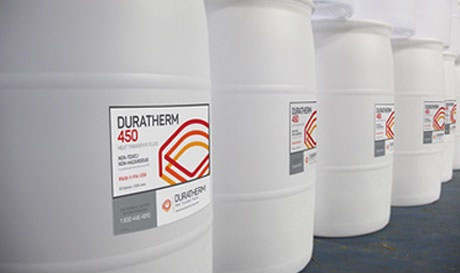How Warmth Transfer Liquid Contributes to Lasting and Cost-efficient Workflow
In the contemporary industrial landscape, the duty of warm transfer liquids (HTFs) in advertising sustainable and inexpensive procedures can not be overstated. These liquids are critical in optimizing thermal administration systems, thus significantly enhancing power efficiency and lowering operational prices. The ecological benefits of innovative HTFs, with their high thermal stability and reduced toxicity, are obvious. They not only prolong system longevity yet also add to the decrease of damaging exhausts. Yet, truth capacity of HTFs is understood through the meticulous option process, guaranteeing compatibility and safety and security. What factors should direct this important choice?
Recognizing Warmth Transfer Liquids
In the realm of thermal monitoring, warm transfer fluids (HTFs) offer as crucial representatives for transferring thermal energy from one area to one more. These fluids play a crucial function in various commercial applications, consisting of chemical processing, power generation, and Cooling and heating systems.
The structure of heat transfer liquids can vary considerably, consisting of choices such as mineral oils, synthetic oils, glycols, and molten salts. Each kind offers distinctive benefits, such as boosted thermal stability, reduced viscosity, and high boiling factors, which are chosen based upon certain operational needs. The choice of HTF influences not only the efficiency of warmth transfer yet likewise the longevity and safety and security of the system in which it is utilized.
As industries continue to introduce, the advancement of sophisticated HTFs, identified by their enhanced thermal conductivity and lowered ecological effect, is crucial for meeting the demands of contemporary thermal monitoring challenges.

Enhancing Energy Effectiveness

Improving power effectiveness has actually ended up being an extremely important problem throughout numerous sectors, motivating a more detailed exam of warmth transfer liquids' duty in maximizing thermal monitoring systems. These liquids are indispensable to keeping the preferred temperature level in processes, thus reducing energy waste and enhancing overall system efficiency. By choosing a suitable warm transfer fluid, markets can substantially enhance their energy performance, leading to reduced energy consumption.

Advanced formulations of warm transfer liquids try these out have been established to endure severe temperature levels while keeping stability and performance. Enhancing energy performance through ideal warm transfer liquid selection is not just a technological necessity but likewise an ecological essential.
Minimizing Functional Prices
Operational expenses are a considerable factor to consider for industries seeking to maintain competitive advantage, and the choice of heat transfer fluid plays a critical duty in cost management. Selecting a suitable warm transfer fluid can cause significant price financial savings by enhancing system efficiency and reducing energy usage. High-performance fluids lessen thermal deterioration, which subsequently minimizes the regularity of liquid substitute and downtime connected with upkeep, therefore decreasing operational expenses.
Moreover, heat transfer fluids with remarkable thermal security and deterioration resistance expand the life-span of devices. This you can find out more lowers the requirement for regular repair services and replacements, which can be costly and turbulent to procedures. By buying top notch fluids, markets can achieve lasting decreases in maintenance prices and boost the dependability of their systems.
In addition, advanced warm transfer fluids commonly exhibit lower viscosity at operating temperature image source levels, which boosts pump efficiency and minimizes power usage in fluid flow. Several contemporary warm transfer liquids are crafted to operate properly over a wide temperature level range, minimizing the need for multiple fluid kinds, thus enhancing supply needs and lowering connected prices.
Ecological Impact Reduction
The push towards decreasing ecological effect has actually obtained energy in sectors leveraging warmth transfer liquids. Firms are significantly identifying the relevance of decreasing eco-friendly impacts by taking on lasting methods. Warm transfer fluids (HTFs) play an essential duty in this change, using chances to improve energy efficiency and reduce exhausts. By picking HTFs with high thermal security and low toxicity, industries can ensure marginal leak and deterioration, thus minimizing hazardous environmental launches.
Moreover, using advanced warmth transfer fluids adds to enhanced system efficiency, minimizing the overall power usage. This decrease not only causes cost financial savings however additionally reduces co2 emissions, assisting in the fight versus climate modification. Liquids that are eco-friendly and recyclable even more boost sustainability efforts, as they lessen waste and promote round economy methods.
In addition, incorporating HTFs into closed-loop systems prevents fluid loss and contamination of the surrounding setting. This method makes sure that fluids are reused, lowering the demand for brand-new sources and limiting waste generation. By accepting these eco conscious methods, sectors can considerably lessen their ecological effect while preserving high functional efficiency, aligning with worldwide sustainability objectives and governing requirements.
Choosing the Right HTF
Selecting the suitable warm transfer fluid (HTF) is a crucial action in progressing environmental sustainability within industrial procedures - heat transfer fluid. An excellent HTF should have a high thermal capacity, reduced thickness, and high thermal conductivity to ensure efficient warmth transfer.
This ensures durability and reduces upkeep expenses. The liquid must be non-toxic and biodegradable, reducing its ecological impact and ensuring compliance with ecological guidelines.
Verdict
